Menu
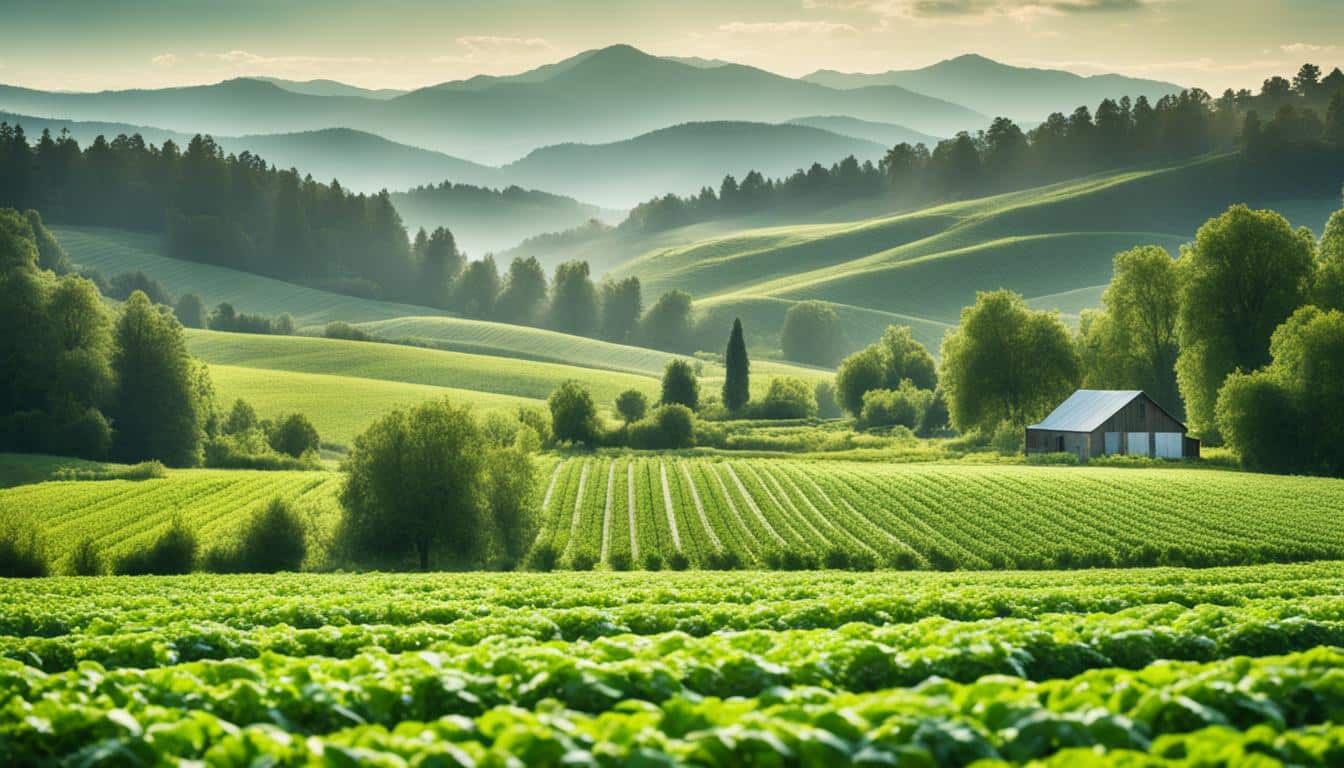
Did you know that organic agriculture is rapidly expanding in the U.S.? It has been growing at double-digit rates for years. This growth continues even when the economy is not doing well. It shows that Americans care about the planet and choose foods grown in eco-friendly ways.
This high demand is opening new doors for farmers who choose sustainable organic agriculture. The National Sustainable Agriculture Coalition (NSAC) is helping these farmers succeed. It works with Congress and the US Department of Agriculture (USDA) to make sure the laws help organic and transitioning farmers. NSAC’s work is vital for the growth of organic agriculture.
NSAC supports methods in farming that protect the Earth. Organic farms help improve the quality of soil and water. They also fight climate change and encourage more plant and animal life. NSAC works to make sure federal programs like the Environmental Quality Incentives Program and the Conservation Stewardship Program help organic farmers. These programs are key for ongoing success in the organic sector.
Organic farmers face unique challenges with traditional crop insurance. They often need extra help because their crops are more valuable. Programs like the Whole Farm Revenue Protection (WFRP) offer better insurance to organic and diverse farms. This program covers more of the farm’s revenue in one policy. There are also assistance programs that help pay for the costs of getting certified organic. These programs can cover up to 75% of the fees, up to $750 for each farm yearly.
Sustainable organic agriculture promotes healthy soil, a balanced environment, and various life forms. It does this without using chemical pesticides or genetically engineered products. As per the 1990 Farm Bill, it’s a complete set of farming methods. These methods aim at lasting benefits for the environment, economy, society, and the well-being of animals.
This method is key in keeping our planet’s ecosystems in harmony while also boosting farm productivity.
Organic farming is more than just a way to grow food. It uses methods that are gentle on nature, helping wildlife and preserving resources. It also ensures that workers are treated fairly, fosters strong family bonds on farms, and supports local communities. Farming sustainably also means caring for animals well.
This care for both people and the environment shows how important sustainable organic agriculture is.
Organic farming has grown a lot, despite facing some obstacles. Issues like expensive certifications for smaller farms and needing a lot of manual work haven’t stopped its growth. Thanks to the Organic Foods Production Act and the National Organic Standards Board, the sector has standards. These developments were supported by organisations like Sustainable Agriculture Research and Education (SARE) and the Environmental Quality Incentives Program (EQIP).
The growth in the market and awareness among consumers and farmers about the benefits are clear. The sector continues to see strong demand.
Education institutions have also played a big part in supporting organic farming. For example, the University of California provides lots of advice on looking after organic crops. Government programmes like the Conservation Stewardship Program and Agricultural Conservation Easement Program help uphold these sustainable practices. Thanks to these efforts, the future of organic farming looks promising.
Eco-friendly farming methods are crucial for the future. They focus on using fewer chemicals and finding ways to control pests naturally. This approach helps crops be stronger and keeps the environment healthy.
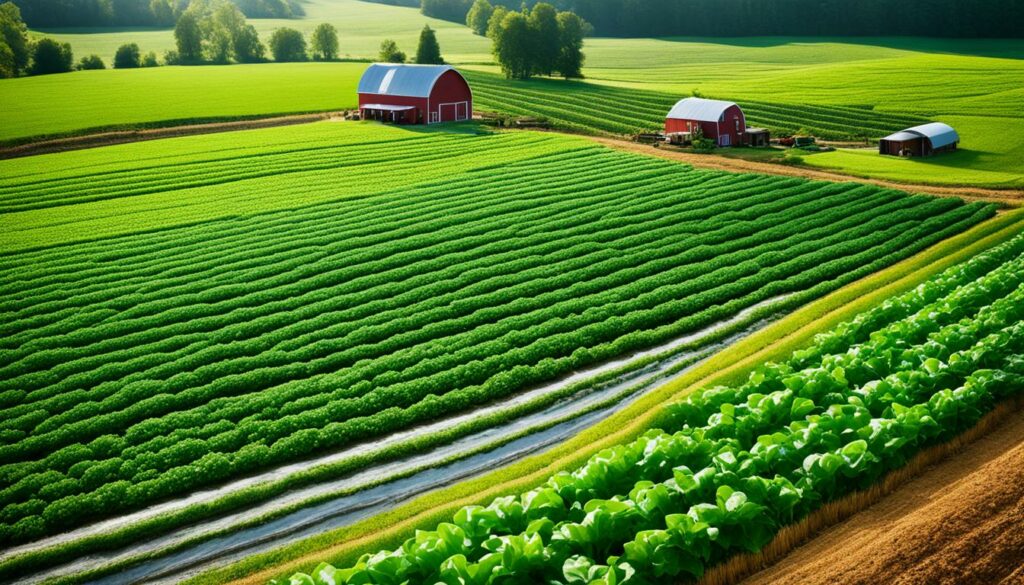
There are ways to use fewer synthetic chemicals in farming. Techniques like crop rotation and cover cropping help a lot. They make the soil healthier, control pests, and reduce the need for chemicals.
Cover crops planted in between harvests stop soil erosion and add nutrients back. This means less fertiliser and herbicides are needed. Not tilling or tilling less also cuts down on soil erosion and helps the soil stay healthy.
Using natural ways to control pests is key in eco-friendly farming. Integrated pest management (IPM) is a big part of this. It mixes different methods to keep pests under control without heavy chemical use.
By encouraging the use of natural enemies and with certain planting techniques, farmers can keep pests away. This also helps the farm’s environment stay diverse and strong.
| Practices | Benefits |
|---|---|
| Crop Rotation | Enhances soil health, controls pests, boosts biodiversity |
| Cover Cropping | Prevents erosion, replenishes nutrients, reduces fertiliser need |
| No-Till/Reduced-Till Methods | Reduces erosion, enhances soil structure |
| Integrated Pest Management (IPM) | Minimises chemical pesticide use, controls pest populations |
In sustainable agriculture, saving water is key to fighting water shortage. By using drip irrigation and recycling, we make sure to use water well. This also helps keep our water systems healthy.
Drip irrigation systems are essential for managing water wisely on farms. They water plants straight at the root, making every drop count. This cuts down on lost water, making growing plants more efficient. Recent studies show it can decrease water loss a lot.
Water recycling in farming is critical for saving water. It means we catch and use water again from many sources, like rain. This method lessens our need for new water, and helps our ground stores stay full. Also, tech like soil moisture sensors help not to use more water than needed.
| Method | Benefit | Efficiency |
|---|---|---|
| Drip Irrigation | Reduces evaporation and runoff | High |
| Water Recycling | Minimises freshwater usage | Moderate |
| Rainwater Harvesting | Recharges groundwater | Variable |
To end, using these smart ways to save water is vital for farming’s future. It makes sure we can keep growing food without using up all our water.
Regenerative farming is key to sustainable agriculture. It aims to improve soil health, boost biodiversity, and make farms stronger. Practices include less tilling, changing crops often, and using natural fertilisers to make soil better and store carbon. This helps farms grow more while helping the planet.
Indigenous groups have used regenerative farming for ages, showing a deep link to nature. Their ancient methods mix well with today’s soil health efforts. This combo can fix ecosystems, fight climate change, and boost economies. Teresa Kaulaity Quintana is a leading figure, spreading the word on Indigenous farming ways.
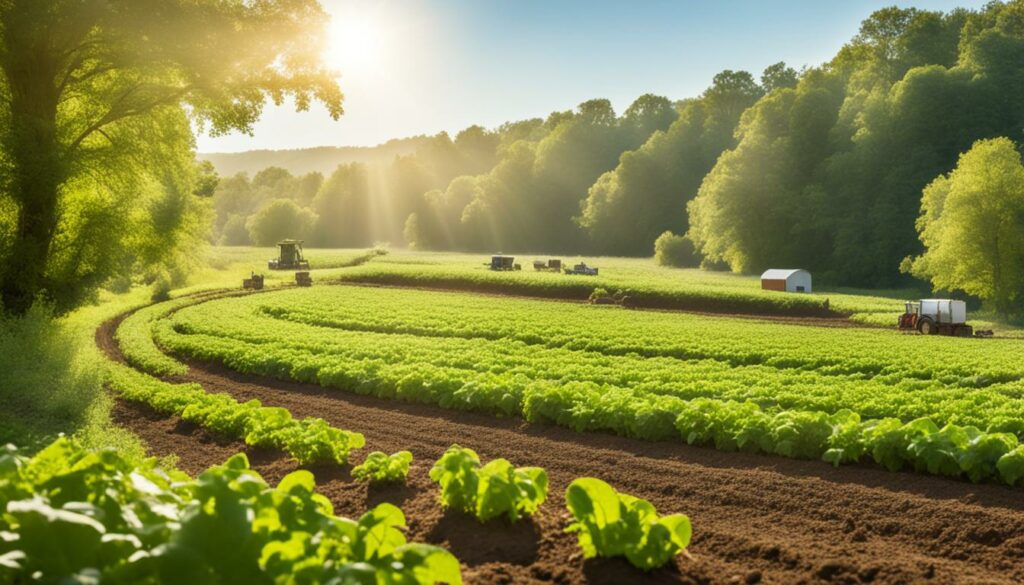
When making rules for regenerative farming, it’s important to think of the community and its history. For example, a lot of farm land is owned by white people in the U.S., not the people of colour. This shows we need rules that treat everyone fairly and equally.
Regenerative farming helps by making the soil and nature richer. It also fights the changing climate by locking carbon into the soil. Empowering farmers to care for their land well is important. They need to know how to make their land healthier.
| Factor | Industrial Agricultural System | Regenerative Farming Practices |
|---|---|---|
| Soil Erosion Rate | 10 to 100 times higher than soil formation | Minimal, due to reduced tillage and cover cropping |
| Biodiversity | Reduced, with monoculture systems | Increased, through diverse crop rotations |
| Carbon Sequestration | Low | High, due to improved soil health |
There’s no one right way to farm sustainably, which means keeping options open is vital. Regenerative farming, praised by the Noble Research Institute, puts soil, water, and nature first. This safeguards a healthy planet for those to come.
Crop diversity has always been important. The Irish potato famine in the 19th century showed the risks of relying on one crop. This disaster happened because only one type of potato was grown. With modern farming, we’ve learned to grow many different types of crops. This helps make farms stronger and more sustainable.
Farming different crops together makes the farm stronger. This technique helps protect against pests and diseases. Different crops act as a natural shield. They also make the soil healthier.
For instance, crops like soybeans can lower the need for harmful fertilizers. Various crops are like an insurance policy for farmers. They help farmers deal with dangerous weather, pests, or sudden changes in the market. This way, they can keep providing food reliably.
Growing a mix of crops can also increase the amount of food a farm produces. By switching crops each season, the main crop can grow much better. This can raise the yield, or amount produced, by 5-30% or even more. Diverse crops in pastures can also improve the quality of the food for animals and make the land more resilient to changes. Sometimes, they even produce more food. This approach has many benefits.
| Benefits | Details |
|---|---|
| Risk Mitigation | Buffers against pests, diseases, and extreme weather |
| Soil Health Improvement | Increases organic matter, nutrient cycling, and reduces erosion |
| Enhanced Yields | Boosts crop yield by 5-30%+ in diverse environments |
| Long-term Fertility | Leguminous crops fix nitrogen, reducing the need for synthetic inputs |
| Economic Stability | Provides diverse income sources and supports food security |
Keeping old farming ways alive is key for the future. These methods, like mixing crops, have been around for ages. They make the soil healthy, save water, and help the land and the plants that grow on it thrive.
Combining these old methods with new ideas helps farming stay healthy and strong. This mix improves the land and farm products. It also protects the environment. We gain a lot by keeping the old ways and adding new ones.
Maintaining soil health is crucial in green farming. Using natural fertilisers and increasing soil’s natural content helps our farms thrive. Here are key ways to keep soil healthy.

Using organic fertilisers is key in keeping our soil strong. These include compost and well-handled animal waste. They provide nutrients slowly, which is great for plant growth.
Cover crops are also important. Crops like triticale, rye, and legumes help keep the ground rich. They also help good bacteria grow, making the soil better for crops.
Building up the soil’s natural matter is essential for its health. This matter makes the soil stick together well, hold water, and feed plants. Things like changing plant types each season, doing less digging, and planting cover crops help a lot.
Soil’s organic matter is a huge store for carbon. It keeps 80% of the world’s carbon on land. But farming has lost a lot of this carbon. This shows we need to farm in a way that lets the soil keep more carbon.
Not digging too much also helps keep the soil healthy. This way, the soil is not as easily blown or washed away. It stays good for the tiny life in it, like worms, that helps plants grow. Good farming methods mean the soil is alive and full of nutrients.
“Perennial crop farmers and interseeding techniques can maintain a continuous cover of diverse vegetation, further promoting soil health and ecological stability.”
Overall, choosing the right farming methods helps our land and the planet. Using natural fertilisers and techniques that keep the soil rich are important steps.
In the world of organic farming, conservation programs are vital for helping farmers. The industry is growing fast. That’s why these organic farming conservation programmes are so important. They offer support for farmers to use sustainable methods and take better care of the environment.
A key program, the Environmental Quality Incentives Program (EQIP), gives both money and expertise to organic farmers. It helps them improve the quality of their soil and water, protect habitats, and make their farms more robust. This support boosts the success of organic farming.
Another important program is the Conservation Stewardship Program (CSP). It pushes farmers to improve how they look after the land. With CSP, farmers can get up to $40,000 per year to follow the best strategies for keeping their soil and natural life healthy. This program also guarantees them a set yearly payment for their environmental efforts.
The National Sustainable Agriculture Coalition (NSAC) stresses the importance of federal support for organic farming conservation programmes. They work with Congress and the USDA’s NRCS to make programs like EQIP and CSP better for organic farmers. Their aim is to focus on needs like managing resources and helping new farmers.
Thanks to the hard work of many, organic farming helps protect the environment and creates new business chances for farmers. The role of tailored conservation programs is huge. They are vital in helping organic farming become more sustainable and successful across the country.
Natural farming methods take a holistic approach. They work to keep agriculture and the environment in harmony. These ways of farming aim for a system that is both sustainable and balanced. They blend old methods with up-to-date ecological ideas.

Organic practices are key in natural farming. They include using local seeds, changing crops each season, and using plant extracts to keep pests away. These methods mean there’s less need for harmful chemicals.
Subhash Palekar Natural Farming is one well-known method. It uses cow dung and urine to make the soil healthier. This also helps cut pollution.
Making the soil better directly is also a big focus. Farmers use compost and natural ways to control pests. By not using man-made products, the plants get stronger. This saves money and makes the farm more natural and lively.
Agroecological systems bring together science and old farming ways. They help mix up crops and grow more than one kind together. This makes the farm stronger against pests and better at growing food.
Zero-budget natural farming shines in how it manages water. It uses methods like mulching and drip irrigation. This reduces waste and makes the soil stay moist. Plus, it helps farmers save money and earn more.
| Technique | Natural Farming | Organic Farming |
|---|---|---|
| Use of Synthetic Chemicals | Avoided Entirely | Minimally Allowed |
| Standards | Local & Traditional | Globally Accepted |
| Water Management | Mulching & Drip Irrigation | Permitted Techniques |
| Inputs | Zero External Inputs | Permits Certain Organics |
| Pest Control | Botanical Extracts | Natural Methods |
It’s crucial to support organic farmers with good federal policies and programmes. This helps the organic agriculture sector grow and stay strong. Organic farmers need these resources to do well in the market.
Key federal policies boost the organic farming sector, which has grown steadily for ten years. These policies help farmers earn more, protect the environment, and provide healthier food. One standout policy is the Whole Farm Revenue Protection (WFRP) from the 2014 Farm Bill. It lets farmers insure their whole farm’s revenue. In its first year, this policy sold over 1,000 plans, a 20% increase from before.
Getting and keeping organic certification can be expensive. That’s why the National Organic Certification Cost Share Program (NOCCSP) and AMA help. They pay back up to 75% of yearly certification costs, with a top payment of $750 per farm each year. This takes a big load off the farmers. NOCCSP works across the US, while AMA is in certain northeast and west states.
| Policy/Program | Details |
|---|---|
| Whole Farm Revenue Protection (WFRP) | Insures entire farm revenue under one policy, with significant uptake in initial years. |
| National Organic Certification Cost Share Program (NOCCSP) | Provides up to 75% reimbursement of year-long certification costs, nationwide availability. |
| Agricultural Management Assistance (AMA) Program | Offers similar reimbursement benefits in specified states, including the northeast and west. |
Strong federal policies and support for certifications help organic farmers a lot. This keeps the industry growing and healthy for everyone.
There’s been a big leap in people wanting organic produce. This demand keeps growing, giving organic product market opportunities to farmers in the US. For over ten years, the sale of organic goods has increased steadily, even a during tough economic times. It’s a strong sign that the interest in organic foods is here to stay.
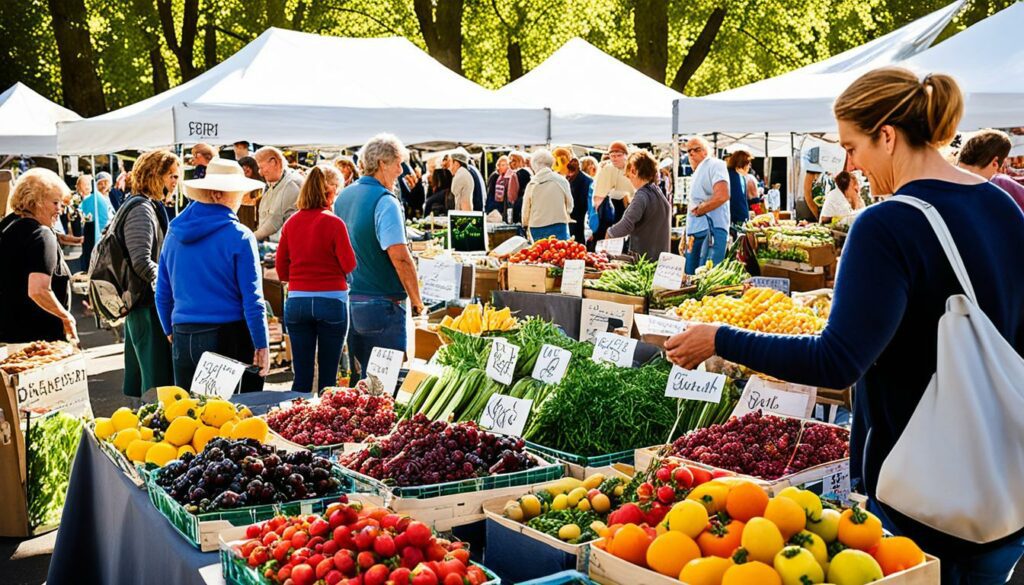
Government efforts have also played a big role in helping the organic farming industry. Programmes like the Environmental Quality Incentives Program’s Organic Initiative (EQIP OI) and Conservation Stewardship Program give support to organic and new organic farmers. They help these farmers use sustainable methods. There are also support programmes like the National Organic Certification Cost Share Program (NOCCSP) and the Agricultural Management Assistance Organic Certification Cost Share Program (AMA). These programmes help by paying for 75% of the cost for getting certified.
Thanks to the 2014 Farm Bill, the Whole Farm Revenue Protection (WFRP) policy helps make sure organic farmers are financially secure. This helps by covering risks to their whole farm’s income with one policy. These efforts show the government’s commitment to helping the organic farming sector grow.
Organic farming is good for the environment. It helps make the soil and water cleaner, adds to the variety of plants and animals, and makes farms less vulnerable to climate change. This helps not only in saving nature but also in making organic farming an attractive choice for agriculture today.
In conclusion, the combination of high demand for organic goods and strong federal help shows the big organic product market opportunities out there. These steps are key in making the organic industry an important part of US agriculture.
Organic farming is growing fast in the U.S. As it grows, it faces unique challenges in getting the right insurance. The organic sector has seen amazing growth for over ten years. But, this quick growth has brought its own set of organic crop insurance challenges.
Valuing their crops is a major issue for organic farmers. In the past, insurance didn’t cover the true value of organic produce. This put organic farmers at a disadvantage. The 2014 Farm Bill tried to help by including more than 50 organic price options by 2016. This was a big step forward. Still, there are hurdles to get insurance that really meets the special needs of organic farmers.
Though things have improved, getting insurance for organic farms is still tricky. Issues like different crops, uncertain yields, and meeting organic standards make it complex. In 2014, the Non-insured Disaster Assistance Program (NAP) added more support, up to 65% of production cost and full crop value. But, we need even more specific plans to manage risks fairly.
The Whole Farm Revenue Protection policy (WFRP) was a big breakthrough for organic farmers. It lets them cover all their farms under one policy. This includes all their organic crops and livestock. This policy was available everywhere and saw a 20% jump in policies sold in 2015.
WFRP stands out by supporting diversity. It gives discounts for up to seven crops and subsidies up to 80%. This makes a real difference for farms that grow a mix of things, organic or not. It really meets the complex needs of organic farming.
| Year | Insured Organic Acreage (USA) |
|---|---|
| 2018 | 1,324,436 acres |
| 2020 | 1,725,245 acres |
Change is happening in organic farming insurance options. The NSAC, USDA, and government have worked together to make things better for organic farmers. But, we need more new ideas to solve the ongoing organic crop insurance challenges. With support and more flexible policies, the organic sector can have strong, fair insurance.
Sustainable organic agriculture brings big wins for the planet and local people. It’s a method that both supports nature and community health. Below, we dive into how exactly it helps us all.
Organic farming is great for the Earth. It enhances soil, keeps water better, and boosts plant and animal life. Without using harmful chemicals, less pollution damages our ecosystems. The method also helps the soil store more carbon, which fights climate change.
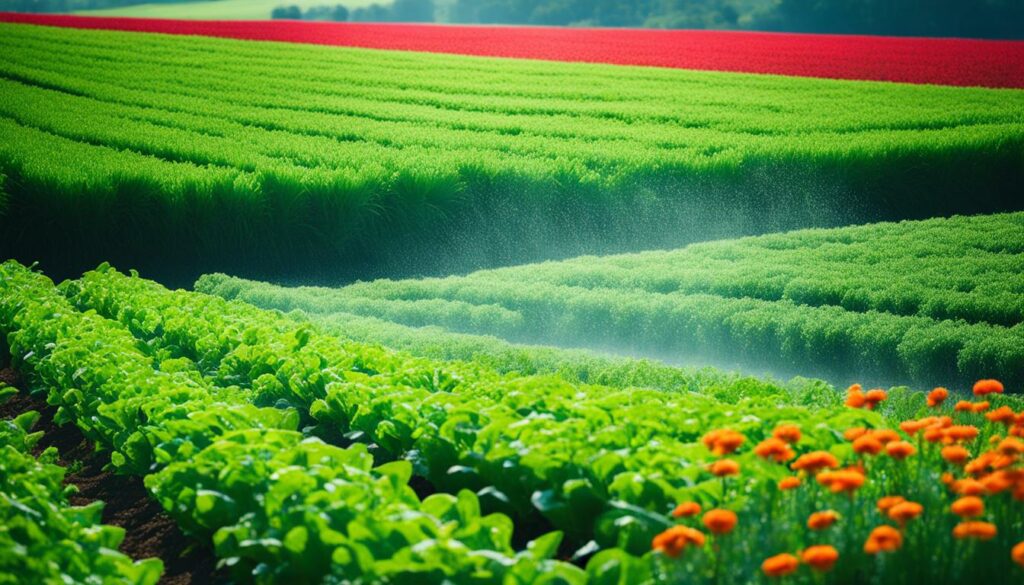
Organic farming’s popularity is growing fast, showing its benefits. The USDA gives a stamp to check if something is organic, ensuring it’s good for the planet. Studies prove it helps control pests naturally and cuts the need for chemicals, making our world a safer place.
Healthy food from organic farming does a lot for people. It means everyone has access to food that’s good and safe. This greatly helps in making us all healthier. Places like farmers’ markets and local farm sales are key. They bring community and healthy eating together.
Organic food also helps local economies. More demand for organic food means more work for farmers. The help they get from certain government programmes makes going organic easier. This way, more farmers can join in on the good work.
| Environmental Benefits | Community Health Advantages |
|---|---|
| Enhanced soil and water quality | Access to healthy, chemical-free food |
| Increased biodiversity | Strengthened local economies |
| Reduced climate disruption | Employment growth in the farming sector |
Mixing the good it does for nature with what it means for us makes organic farming powerful. This way, we build a food system that’s good all round. It keeps us and the Earth safe, leaving a bright future for those who come after us.
Looking after biodiversity and saving wildlife habitats in farming are crucial for sustainable methods. We should keep a mix of plants and animals on farms. This helps make the environment more complex and steady.

About a third of the Earth’s lands grow crops or have pastures. This affects at least 30% of the whole land. It shows how important it is to keep our farming practices good for nature. Doing this helps wildlife in farms to grow, making the areas more alive.
It’s interesting that over 1.1 billion people live where nature is richest. Many of them work in farming. This shows that we can farm well and save nature at the same time. Using smart methods, like planting different things together, helps keep the environment strong for animals and plants.
| Metrics | Statistics |
|---|---|
| Land Dedicated to Agricultural Crops or Planted Pastures | 30% of terrestrial lands |
| Land for Extensive Livestock Grazing | 10-20% |
| Food Production in Natural Forests | 1-5% |
| Global Influence of Productive Activity on Habitable Lands | 80-90% |
| Wetlands Lost in California | 91% |
| Freshwater Used by Agriculture | 70% |
| Projected Increase in Global Livestock Product Consumption (2020) | far from 303 million metric tonnes in 1993 to 654 million metric tonnes |
As farming changes, we need to make it better for the planet. It’s important to use methods that help farming work with nature. These ways also stop harm to the environment, which comes from old farming methods.
Finally, more and more people want farming that’s good for Earth. This shows the need for everyone to choose ways of farming that are not just good for food but also for the planet and the creatures living here.
Being responsible with livestock is key to our eco-friendly farming. It helps over 1.3 billion people and is a big part of global farming value.
Looking after farm animals well is crucial in good farming. We make sure animals are healthy and happy. This includes choosing the best animals and feeding them well so they need fewer to produce goods.
How we deal with manure is important for the earth. It helps soil stay healthy and cuts down on bad waste. Good manure use also helps lower the gases that hurt our planet.
The farming sector makes a big part of the gases that warm our planet. Using farming methods that are good for the land helps cut these gases. And, smart ways to farm actually help make more milk while saving money and the environment.
Good farming is not just about food. It also helps keep the environment safe and people making a living. By being kind to animals and taking care of waste well, we build a farming system that lasts.
Strengthening local food systems is critical for sustainable organic farming to grow. It includes helping local farmers and cutting down on food miles. As more people want local food, rural areas see new jobs and chances to grow.
Backing local organic farmers is essential to make strong food chains. The National Institute of Food and Agriculture (NIFA) gives support and leads efforts. These aim to make food safer, healthier, and to get more people eating locally. For example, the Beginning Farmer and Rancher Development Program teaches new farmers how to grow sustainable food. It gives them what they need to succeed.
Lessening the distance food travels is key to local food systems. By buying food close by, we cut the harm of moving it far. Initiatives like the Gus Schumacher Nutrition Incentive Program show how local food helps economies. NIFA also works on ways to cut down food waste and improve how we farm. These efforts help make food systems better for everyone involved.
NIFA supports local and regional food production through resilient and fairer markets for all producers, as evidenced by the twelve Regional Food Business Centers serving all states, Tribal nations, and territories.
More than 1,300 businesses and people have asked for help from the USDA since March 2022. Local food systems not only open new jobs but also connect buyers with the makers. This builds a feeling of community and helps the environment. The Niche Meat Processing Assistance Network (NMPAN) and new programs like NC FarmsSHARE show a dedication to local foods.
| Programme | Impact |
|---|---|
| Gus Schumacher Nutrition Incentive Program | $85 million economic impact |
| Beginning Farmer and Rancher Development Program | Education on sustainable practices |
| NIFA initiatives | Support for local and regional systems |
| NC FarmsSHARE | Response to COVID-19 pandemic |
Sustainable organic agriculture is a modern approach that joins economic success with caring for the planet. People are becoming more aware of the harm traditional farming does to our world. This makes many turn to organic goods. Encouraging sustainable agriculture meets the growing call for farming that’s good for nature.
Support, like help from governments, is key for the future of organic farming. This includes direct money to farmers and other forms of aid for learning, studying, and selling. Even though organic farming is small in the market, it can help farmers earn more and make local food supplies safer. Organics also stand up better to bad weather, like droughts, helping keep food sources steady.
Organic farming offers many pluses, like less soil damage, better water, fewer toxins in the environment, and healthier food. With help from authorities in research, learning, and checking standards, going organic is more appealing. Supporting organic farming means we’re working towards a stronger, healthier food system for the future.
Sustainable organic agriculture prioritises soil health and biodiversity. It avoids harmful chemicals. This method helps protect the environment and supports nutritious food.
Organic agriculture has grown a lot. It now has more market opportunities. More farmers and consumers are aware of its benefits.
To reduce chemicals, farmers use methods like crop rotation. They also plant cover crops. Adding organic materials to the soil helps, too.
Cultural methods, like crop rotation, are used for pest control. They enhance crop health without chemicals. This makes crops more resilient.
To save water, farmers use drip irrigation and recycle water. These methods help in efficient water usage. They also cut down on water waste.
Regenerative farming involves methods that are good for the soil. These include diverse crops and minimal tilling. These practices make farms stronger over time.
Crop diversity is key for healthy soil and plant health. It deters pests and helps crops withstand bad weather. This makes farming sustainable.
Traditional farming looks after nature and uses its principles. It has evolved over time to fit with nature’s needs. This helps in being sustainable.
To keep soil healthy, use organic fertilisers and manage manure well. Cover crops and less tilling help, too. These methods help produce and conserve the land.
Conservation programs offer support for organic farming’s environmental efforts. They aim to keep improving how organic farms help the planet. Organizations offer help and resources.
Natural farming uses practices that are close to nature. They focus on healthy soil and living in harmony with the environment. This means using fewer synthetic products.
It’s done through policies that help with certification costs. The USDA and NSAC offer support. These efforts are to make the organic sector stronger.
The market for organic goods has grown a lot. Marketing support has improved. Programs help with the costs of becoming certified.
Organic farmers can adjust their insurance to cover their crops’ true value. The Whole Farm Revenue Protection policy helps cover the farm’s income. This includes unique challenges of organic farming.
It improves soil and water, increases plant and animal variety, and stands strong against climate change. It benefits the environment greatly.
Sustainable farming offers healthy food and supports the local economy. It also connects people with where their food comes from. This all improves community health.
Biodiversity makes farms more stable and productive. It supports the environment in many ways. This leads to long-term benefits for farming.
It means looking after animals well and handling manure in a way that helps the soil. It cuts down on pollution and treats animals with care.
By buying from local organic farmers, local food systems get stronger. This reduces transport and boosts community health and the environment.